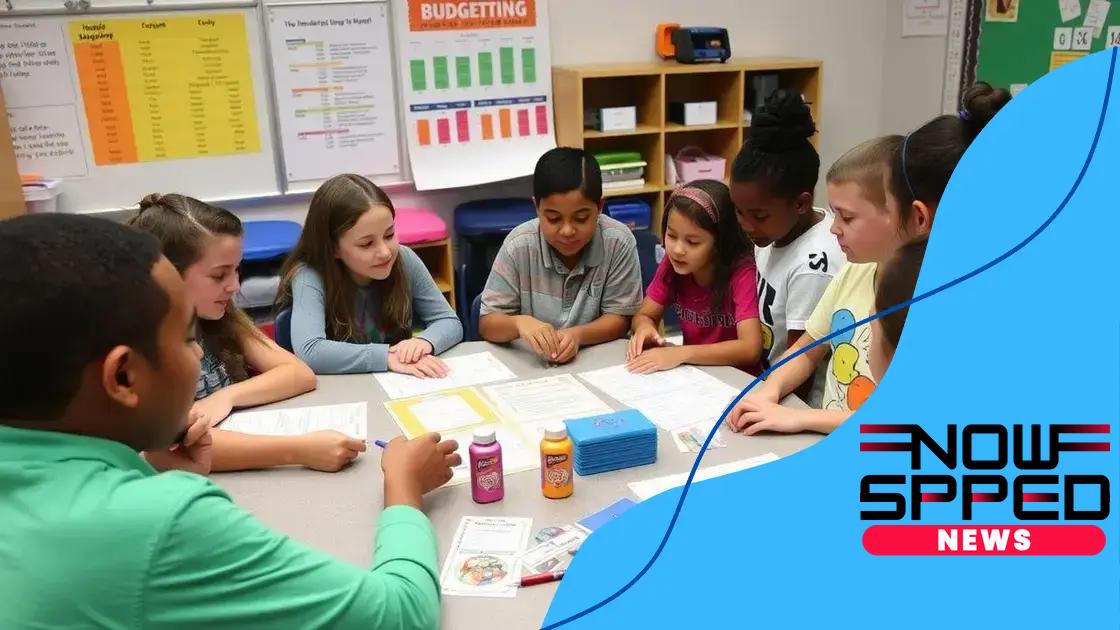Financial literacy education for middle school students

Financial literacy education for middle school students equips them with essential money management skills through engaging activities, supportive parental involvement, and practical resources, shaping their future financial decisions.
Financial literacy education for middle school students plays a vital role in shaping their future. Have you ever thought about how understanding money management can impact their daily lives? Let’s dive into effective strategies and fun activities to make this learning journey exciting.
The importance of financial literacy
The importance of financial literacy can’t be overstated, especially for young students. Understanding money at an early age prepares them for challenges in the future. It builds confidence and enables smart decision-making.
Many teens are highly interested in spending and saving but often lack the fundamental knowledge to manage their finances wisely. With a solid foundation in financial literacy, middle school students can grasp key concepts that shape their relationship with money throughout their lives.
Key benefits of financial literacy
Financial literacy provides numerous advantages for young learners. Here are some significant benefits:
- Improved money management skills.
- Greater ability to set and achieve financial goals.
- Increased responsibility and understanding of consequences.
- Enhanced problem-solving skills related to financial issues.
By being financially literate, students gain a sense of empowerment. They feel in control of their financial decisions and understand how to budget and save for their futures.
Moreover, they can differentiate between wants and needs, allowing them to make informed choices about spending. As they learn to prioritize saving and investing, they prepare themselves for greater financial independence as adults.
How financial literacy impacts the future
For many, financial literacy is a precursor to financial stability. When students possess this knowledge, they are less likely to fall into debt or face financial crises later in life. They learn that money management is crucial for achieving their dreams, whether it’s buying a car, going to college, or starting a business.
Furthermore, understanding the value of credit is essential. Students who grasp how credit works can maintain good credit scores, which will benefit them when applying for loans or mortgages in the future.
In summary, financial literacy education not only fosters essential skills but also shapes a confident and capable future generation. It’s a journey that equips students to face financial realities with excitement rather than fear.
Key concepts to teach middle schoolers
Teaching key concepts of financial literacy to middle schoolers is essential for their development. Students should grasp fundamental principles that will aid them in managing money effectively.
Starting with basic terminology is essential. By understanding words like budget, savings, and interest, they can navigate financial discussions confidently. These terms form the foundation of their financial knowledge.
Essential financial concepts
Here are crucial concepts that middle school students should learn:
- Budgeting: Understanding how to plan and track income and expenses.
- Savings: The importance of setting aside money for future needs and goals.
- Investing: Basic knowledge of how money can work for them over time.
- Credit: Grasping how credit works and its impact on financial decisions.
In addition to definitions, practical application is vital. Have students practice creating a simple budget based on a hypothetical allowance or earnings. This not only reinforces what they’ve learned, but also helps them visualize real-life scenarios.
To further enhance their understanding, introduce concepts like needs vs. wants. Help students differentiate between what they truly need and what they desire. This vital skill will aid them in making informed spending decisions later.
Real-world applications
Relating financial concepts to everyday life can spark students’ interest. Discuss current events, such as how changes in the economy affect them personally, or how small businesses operate. Connect lessons to the real world, emphasizing their relevance.
Additionally, encourage students to set personal financial goals. Whether saving for a new video game or planning a trip, goal-setting fosters responsibility and motivation for managing money wisely.
Overall, educating middle schoolers about these key financial concepts prepares them for a successful future, equipping them with skills that can last a lifetime.
Engaging activities for financial education

Engaging activities for financial education can make learning fun and interactive for middle school students. It’s important to connect lessons with real-life experiences, allowing students to practice what they learn in a hands-on way.
One effective activity is the budgeting game. In this game, students receive a fictional income and must allocate money to various expenses, such as housing, food, and entertainment. This simulation helps them understand budgeting while fostering discussion about priorities.
Creative interactive projects
Another great way to teach financial literacy is through projects. Students can work in groups to create a business plan for a mock company. They will need to outline how they will earn money, manage expenses, and even handle marketing. This project promotes teamwork and critical thinking while applying financial concepts.
- Market Day: Host a market day where students create products to sell. They must determine pricing and understand profit margins.
- Financial Literacy Fair: Organize a fair where students present on different financial topics they researched. This encourages them to teach others what they learn.
- Stock Market Simulation: Allow students to track stocks or create a game on stock trading. They learn about investing by following market trends.
Incorporating technology can also enhance financial education. Utilize apps that allow students to practice budgeting or managing virtual savings accounts. These tools make learning relevant in today’s tech-savvy world.
Engagement is key. Use role-playing scenarios to teach about loans and interest rates. Have students act out how to handle financial challenges in various situations. This hands-on approach helps solidify their understanding.
By incorporating these engaging activities into lessons, educators can inspire a love for learning about finance. Students will leave with practical skills they can use now and in the future, making financial literacy an exciting topic.
How parents can support learning
Parents play a crucial role in supporting their children’s financial literacy education. By being involved, they can enhance their child’s learning experience and instill valuable money management skills.
One effective way parents can help is through open discussions about money. Families should encourage conversations about income, saving, and spending. This not only provides real-life context but also normalizes the topic of finances.
Practical strategies for support
Utilizing everyday experiences can reinforce learning. For instance, when shopping, parents can explain how to compare prices or identify needs versus wants. Engaging children in these choices cultivates their budgeting skills.
- Set an example: Parents should model good financial habits, like saving or budgeting.
- Teach goal setting: Encourage children to plan for short- and long-term goals, like saving for a toy or a future trip.
- Offer regular discussions: Make finance a regular topic at home, allowing kids to ask questions and express their thoughts.
- Involve them in family budgeting: Discuss how the family allocates money for different needs.
It’s important for parents to participate in learning activities as well. They can join in on fun financial education games or help kids complete projects related to money. This involvement makes the learning process enjoyable and collaborative.
Encouraging children to manage a small allowance or savings account can also provide hands-on experience. By tracking their spending or savings, they learn responsibility and the importance of managing money well.
Resources for parents
Parents should seek out tools and resources to assist in this learning journey. There are many age-appropriate books, online courses, and apps designed to teach children about financial literacy. These resources can make learning engaging and applicable.
Ultimately, with the right support from parents, children can build a strong foundation for their financial futures. By nurturing their understanding of money, parents equip their kids with the skills they will need for a successful and financially savvy life.
Resources for enhancing financial skills
Utilizing proper resources is key to enhancing financial skills among middle school students. These resources can provide valuable information and engaging ways to learn about managing money effectively.
One excellent option is to incorporate books specifically designed for young learners. There are many titles that explain financial principles in an easy-to-understand manner. These books can include interactive elements like quizzes and activities that reinforce lessons.
Online resources and apps
Additionally, online platforms offer a wealth of information. Websites dedicated to teaching financial literacy provide informative articles, videos, and interactive tools that make learning more enjoyable. Many of these resources are free, making them accessible to all students.
- Budgeting apps: Apps like Mint and YNAB help students track their spending and savings in a visually appealing way.
- Educational games: Websites that feature financial games make learning fun. Games can simulate real-life scenarios, teaching students about budgeting, saving, and investing.
- Podcasts and videos: Using podcasts or YouTube videos on financial topics can engage students visually and audibly.
Incorporating interactive lessons is also beneficial. Use online simulations where students can practice investing or creating budgets in a risk-free environment. These simulations can help students understand the consequences of their financial decisions in real time.
Community resources
Local organizations often provide workshops that focus on financial education. These workshops can be tailored specifically for young learners, offering engaging activities and expert advice. Parents can encourage their children to attend these workshops for hands-on experience.
Finally, involving students in discussions about current events related to finance helps solidify their understanding. Talking about real-world stories about financial successes and failures can make the concepts more relatable and practical.
By taking advantage of these various resources, students can significantly enhance their financial literacy, paving the way for informed decision-making in the future.
FAQ – Frequently Asked Questions about Financial Literacy Education
Why is financial literacy important for middle school students?
Financial literacy is crucial as it equips students with essential skills to manage money, make informed decisions, and plan for their futures.
What engaging activities can help teach financial literacy?
Engaging activities include budgeting games, creating mock business plans, and running market days where students sell products.
How can parents support their child’s financial literacy education?
Parents can support learning by discussing financial topics openly, involving their children in budgeting activities, and modeling good financial behavior.
What resources are available for enhancing financial skills?
Resources include books, educational apps, online tutorials, and community workshops that focus on practical financial concepts for students.





